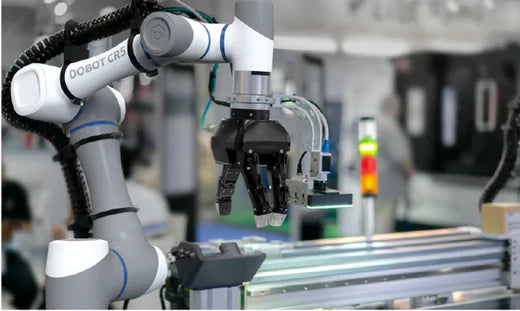
Collaborative Robots: Revolutionizing Industry
Share

Introduction
In the ever-evolving landscape of industry, technological advancements have proven pivotal in shaping the future of productivity and innovation. Among these advancements, collaborative robots—or cobots—have emerged as transformative agents across various sectors. Designed to work alongside humans efficiently, safely, and intelligently, cobots are revolutionizing industries and propelling enterprises to the forefront of innovation. This blog explores the transformative potential of cobots, highlighting their role in boosting growth and steering industries into an era of unparalleled productivity.
The Rise of Collaborative Robots in Industry 5.0
As industries transition into the era of Industry 5.0, collaborative robots take center stage. This new paradigm emphasizes the synergy between smart technologies and human intelligence, creating a connected and responsive industrial ecosystem. Unlike traditional automation, Industry 5.0 integrates cobots as vital components of a holistic production system. Their ability to collaborate with human workers makes them indispensable in fostering innovation and enhancing operational efficiency.
Enhanced Productivity and Efficiency
Cobots are not designed to replace human labor but to complement it. By automating routine and repetitive tasks, cobots enable human workers to focus on more intricate and creative aspects of their roles. This division of labor leads to:
- Increased Productivity: Streamlining processes and reducing delays.
- Enhanced Efficiency: Improving output quality while maintaining consistency.
- Workforce Optimization: Allowing human talent to address strategic and creative challenges.
Safety Reinvented
A hallmark of collaborative robots is their commitment to safety. Unlike traditional industrial robots that require physical barriers to ensure worker safety, cobots are equipped with advanced sensors and artificial intelligence. These features enable cobots to:
- Detect human presence and adjust movements accordingly.
- Minimize the risk of workplace accidents.
- Foster a secure environment where humans and robots can collaborate seamlessly.
This safety-first approach not only boosts worker confidence but also reduces liability concerns for businesses.
Cost-Efficiency and Return on Investment (ROI)
While the initial cost of deploying collaborative robots may seem significant, their long-term benefits far outweigh the investment. Key advantages include:
- Error Reduction: Minimizing mistakes in production processes.
- Enhanced Speed: Accelerating production timelines.
- Waste Minimization: Ensuring optimal use of resources.
Additionally, the ease with which cobots integrate into existing workflows ensures that businesses can quickly achieve a tangible return on investment, making them a financially sound choice for enterprises of all sizes.
Workforce Empowerment and Skill Enhancement
Contrary to fears of job displacement, cobots empower employees by alleviating them from monotonous and physically demanding tasks. This shift offers:
- Job Satisfaction: Allowing workers to engage in more meaningful roles.
- Skill Development: Encouraging the workforce to focus on creativity, problem-solving, and interpersonal skills.
- Adaptability: Preparing employees for the demands of a technologically advanced workplace.
By fostering a collaborative environment, cobots contribute to a more skilled and satisfied workforce.
Accelerated Research and Development
In innovation-driven industries, cobots play a critical role in accelerating research and development. Their proficiency in handling repetitive tasks such as data analysis, experimentation, and prototype testing allows:
- Researchers to allocate more time to ideation and innovation.
- Engineers to refine designs with greater precision.
- Businesses to bring new products to market faster, gaining a competitive edge.
Conclusion
Collaborative robots have emerged as the cornerstone of the modern industrial revolution, reshaping business operations and workplace dynamics. Their integration into various sectors not only enhances productivity and efficiency but also empowers the workforce and accelerates innovation.
For investors, cobots represent a strategic opportunity to tap into a rapidly growing market poised to transform industries worldwide. As businesses strive to remain competitive in an ever-changing global landscape, embracing collaborative robots is not just a choice but a necessity. The future is collaborative, and cobots are leading the way.